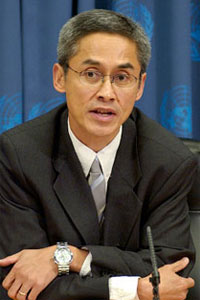The close connection between migration, human rights and climate change is increasingly self-evident, as "natural disasters" related to that linkage loom in many parts of the world. The Office of the UN High Commissioner for Human Rights (OHCHR) estimates that about 22.5 million people migrate each year within and across borders because of climate change and weather-linked disasters. These are all compounded by the spread of Covid-19 in terms of lockdowns and other restrictive measures.
How should Asian countries respond? On an encouraging note, Asian countries have participated well in the various climate change-related treaties and instruments, in particular the International Framework Convention on Climate Change and the more recent Paris Agreement, in terms of their acceptance of those standards. The goal of limiting the rise in global temperature not to exceed 1.5C pursuant to the Paris Agreement is generally accepted, and countries participate in the monitoring and review process, including submitting Nationally Determined Contributions (NDC). They agree to enhance such contributions in relation to mitigation and adaptation from fossil fuels with a view to decarbonisation. However, there is a need to link those commitments with human rights standards and obligations, in addition to rules concerning the humane treatment of migrants.
Various corners of the Asian region have sub-regional organisations which can deal with migration, human rights and climate change. In one sub-region, the Association of Southeast Asian Nations (Asean) has various declarations, plans of action and mechanisms to deal with all three issues, encouraging a non-segmented approach to overcome the "silo mentality". Its main human rights body, the Asean Intergovernmental Commission on Human Rights organised, for example, in 2021 a regional meeting on that trio of issues. It highlighted various substantive and procedural issues such as access to information, people's participation, access to justice, a rights-based approach to environmental decision-making and a rights-based approach to environmental impact assessment. There are also some regional treaties on the issues concerned; these include the 2002 Asean Agreement on Transboundary Haze Pollution and the 2005 Asean Agreement on Natural Disasters and Emergency Response. An incisive Declaration was the 2019 Asean Declaration on the Rights of Children in the Context of Migration which underlined the need to avoid detaining children in immigration situations, thus complementing a similar axiom in the Global Compact on Migration.
The South Asian region, with its huge population, is another key entry point, especially because its many low-lying geographies are particularly disaster-prone due to rising sea levels, flooding, cyclones and other risks. Regional cooperation has been possible under the South Asian Association for Regional Cooperation (Saarc). Initiatives include the 2008 Declaration on Climate Change which calls for cooperation on adaptation to climate change; the 2010 Saarc Convention on Cooperation on the Environment; and the 2011 Saarc Agreement on Rapid Response to Natural Disaster.
In regard to central and east Asia, there is the Shanghai Cooperation Organization which is more of a security organisation. In 2018, it broadened its scope by inviting its members to adopt the concept of cooperation in the field of environmental protection, underlining the preservation of biodiversity.
At the national level, implementation of international standards on the question at hand should bear in mind the context prevalent in Asia. There are key challenges of democracy, human rights, peace and sustainable development that shape or condition the national response to migration, rights' adherence and climate change-related action.
All countries have some laws, policies, programmes and practices relating to the issues in question. There are the ubiquitous national development plans, environmental laws and inputs for NDC. For example, Thailand's Masterplan on Climate Change 2015-50 commits to 40% greenhouse gas/carbon emissions' reduction by 2030 as part of the NDC. The National Adaptation plan is being formulated on the basis of water management, human settlement, food security, tourism, public health and natural resources.
A synchronised and calibrated approach between migration, human rights and climate change is essential. In particular, the climate change dimension calls for not only mitigation measures, such as decarbonisation, but also adaptation measures, such as change in town and country planning to prepare for climate change, and a shift to clean and green energy such as solar and wind energy. This may entail incentives from the state, such as tax deductions for solar panels, so as to enable adaptation. There is a need for consistent data collection and assessments of climate change, bearing in mind the precautionary principle which enables preparedness to take place, even if the data are not altogether clear.
The human rights dimension is based on non-discrimination which implies that the rights must be respected for all persons -- nationals and non-nationals. On a related front, at the recent 26th UN Climate Change Conference (COP26) in Glasgow, there was much more recognition of indigenous peoples as the custodians of forestation and preservation of natural resources who can help reduce harm to the environment.
Another key determinant is the role of human rights defenders and environmental defenders and the need to respect their advocacy. There is the parallel call for more fulfilment of procedural rights, such as access to information, people's participation and access to justice and remedies.
This is complemented by the need for international solidarity to help the national and local setting, and once people are on the move, there is the shared responsibility to help shoulder the load carried by the area to which they migrate. Collaterally, there is the call for the humane application of national immigration law not to exclude cross-border victims but to assist them as humanitarian cases, offering at least temporary protection and shelter.
